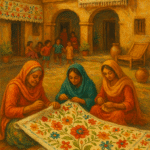What Artists Collect: Stones, Tickets, Rusted Nails and Why It Matters
Found Objects in Artistic Practice
There’s a quiet ritual many artists follow: collecting small, ordinary things that others might overlook. A chipped tile, a rusted nail, a worn bus ticket—none of these have immediate material value, yet they speak. For me, these found objects do not enter the painting in their physical form, but they become recurring motifs—painted with precision, remembered with feeling. This blog explores how found objects in artistic practice act as emotional anchors, visual metaphors, and silent storytellers.
Painting Memory Through Objects
I do not embed these objects onto the canvas—I do something more intimate: I paint them. Each object I choose to render is remembered, not replicated. That old rusted nail I once found under a staircase in our ancestral home often reappears in my work—not as an object, but as a symbol. It is a carrier of memory: the musty scent of monsoon wood, the creak of the floor above, the echo of an unseen presence.
Stones, petals, fragments of cloth, or scrap paper—these are not props but presences. When painted, they lose their decay and become fixed in a moment of emotional clarity. They hold still the sensation that made me pick them up in the first place.
The Emotional Weight of the Discarded
Found objects often carry what language cannot: touch, texture, decay. When I paint a torn piece of fabric or a faded label, I’m not documenting it—I’m inviting the viewer into a moment of felt history. Each object I depict carries emotional sediment. These are not simply illustrations; they’re attempts to preserve the weight of an unnoticed world.
There’s a strange nobility in the discarded. What rusts, breaks, fades—often holds more story than what shines. Painting such objects is a gesture of respect. It says: “You mattered, even in silence.”
Why Artists Collect
The act of collecting is, at its core, about attention. To collect is to notice. Over the years, I’ve found myself drawn to the unremarkable—scraps, stones, half-burnt matchsticks. They sit in bowls or drawers, not as relics, but as quiet companions. When the time comes, I paint them—not for what they are, but for what they made me feel.
This process becomes a form of self-mapping. The objects I choose to render on canvas mirror inner shifts—moments of waiting, remembering, or release.
The Power of Repetition
Some motifs return again and again. A stone I once carried in my pocket as a child. A metal bolt from an abandoned railway bench. A crumpled movie ticket that reminds me of solitude. They reappear, often altered slightly, in my works—like refrains in a poem.
In doing so, I build my own visual vocabulary. These are not just aesthetic choices; they are emotional bookmarks, holding place in my inner archive.
Painting the Quiet Witnesses
Found objects in artistic practice don’t have to be physically embedded to shape a work. Sometimes, painting them allows for a deeper transformation—they become icons of personal memory, carriers of invisible weight.
To paint these objects is to give them voice. To say: You were seen. You were felt. You were held.
And through that act, I find myself seen too.


